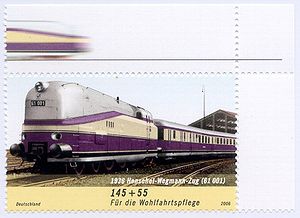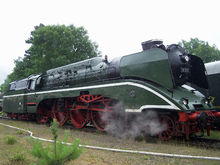- DRG Class 61
-
DRG Class 61 
Number(s): DRG 61 001 DRG 61 002 Quantity: 1 1 Manufacturer: Henschel Year of manufacture: 1935 1939 Retired: 1952 Rebuilt to
18 201Wheel arrangement (Whyte): 4-6-4T 4-6-6T Axle arrangement ((UIC): 2'C2' h2 2'C3' h3 Sub-class: St 37.18 St 38.18 Length over buffers: 18.475 m (60.61 ft) 18.825 m (61.76 ft) Gauge: 4 ft 8 1⁄2 in (1,435 mm) Service weight: 129.1 t (127.1 long tons; 142.3 short tons) 146.2 t (143.9 long tons; 161.2 short tons) Adhesive weight: 56.7 t (55.8 long tons; 62.5 short tons) 56.3 t (55.4 long tons; 62.1 short tons) Axle load: 19 t (19 long tons; 21 short tons) 18.8 t (18.5 long tons; 20.7 short tons) Top speed: 175 km/h (109 mph) Indicated power: 1,066 kW (1,430 hp) Driving wheel diameter: 2.300 m (7 ft 6.6 in) Leading wheel diameter: 1.100 m (3 ft 7.3 in) Trailing wheel diameter: 1.100 m (3 ft 7.3 in) Cylinder diameter: 460 mm (18 in) 390 mm (15 in) Piston stroke: 750 mm (30 in) 660 mm (26 in) Boiler overpressure: 19.6 bar (1,960 kPa) Grate area: 2.75 m2 (29.6 sq ft) 2.79 m2 (30.0 sq ft) Superheater area: 69.2 m2 (745 sq ft) 73.4 m2 (790 sq ft) Evaporative heating area: 151.65 m2 (1,632.3 sq ft) 149.82 m2 (1,612.6 sq ft) Brakes: Hildebrand-Knorr automatic Schnellbahnbremse with auxiliary brakes and counterweight brake. Operating on both sides of all coupled and carrying wheels. Water capacity: 17,000 l (3,700 imp gal; 4,500 US gal) 21,000 l (4,600 imp gal; 5,500 US gal) Fuel capacity: 5.0 t (4.9 long tons; 5.5 short tons) coal 6.0 t (5.9 long tons; 6.6 short tons) coal The two German DRG Class 61 steam engines were express train locomotives specifically built by Henschel for the Henschel-Wegmann train in service with the Deutsche Reichsbahn. The Henschel-Wegmann train was an initiative of the German locomotive construction industry, intended to be able to demonstrate a powerful locomotive-hauled train alongside the emerging express railbuses.
Contents
Construction
Because it was planned to run the train in shuttle services to a tight time schedule, it was necessary that the engine could run at top speed in both directions. This resulted in a tank locomotive rather than the tender locomotive design otherwise used for long-distance high-speed links. In order to be able to attain the high running performance aimed at, locomotive and coaches were designed to be especially light, albeit the coal and water supplies had still to be sufficient for a one-way trip on the planned route.
In building them, component designs from the Deutsche Reichsbahn's standard steam locomotives (Einheitsdampflokomotiven) were used as far as possible but, in quite a number of areas, other components were used. The boiler overpressure was set at the higher level of 20 atm (19,6 bar), whereas those of the standard locos were operated at 16 atm (15,7 bar). Both locomotives were fitted with a streamlined shell. The water tank tapered at the front and gave the engine driver and stoker and good all-round view of the line. The "cover plates" covered the drive completely.
In contrast to the first engine, 61 002, which was built later, had a drive with three cylinders and larger supply tanks. To support the latter, the rear carrying bogie was extended to three axles. As a result of the more powerful drive, the punctuality of the train was improved - it had been unsatisfactory with 61 001. In addition the second locomotive had smoke deflectors on top next to the smoke exhaust, which were not fitted to 61 001.
Operation
With its 2.30 metre diameter driving wheels the locomotive itself achieved the planned speed of 175 km/h without any difficulty, but when hauling its streamlined train it could only reach 160. Nevertheless the scheduled service between Dresden and Berlin was successfully delivered, the 176 kilometre long route being completed in just 102 minutes, a time that, even today (2008), has still not been beaten on this route despite the use of faster electric locomotives. However it was pushed to complete the short turnaround allowed in Dresden because the locomotive not only had to run around, but also replenish its supplies.
When 61 001 was not available or when either scheduled or unscheduled work was being carried out on her, a DRG Class 01 or DRG Class 03 headed the train. But with top speeds of only 130 km/h they could not match that of 61 001 by a long way, however.
Not long after construction work had begun on 61 001, its variant, 61 002, was planned and built at the start of 1939. In May the first factory trial runs were carried out and the locomotive was transferred on 12 June 1939 to the locomotive depot (Bahnbetriebswerk or Bw) at Grunewald. It was probably taken into service at the turn of the year in 1939/40, so it clearly would not have been hauling the streamlined train in regular passenger service, due to the outbreak of the war and the use of the Henschel-Wegmann train for Deutsche Wehrmacht purposes.
After the cessation of the train's operations at the start of 1939, 61 001 was used for heating duties at Bw Berlin-Grunewald. From December 1940 it found itself once again in Dresden-Altstadt on express train services and was given conventional train and buffer equipment in November 1942. Its operations log shows that it only made a few runs however. From 1943 to the war's end, the Reichsbahn repair shop (Reichsbahnsausbesserungswerk or RAW) at Braunschweig was responsible for the engine. Between July 1945 and March 1946 it travedlled about 40,000 kilometres hauling passenger trains.
Survival post-1945
Locomotive 61 001 found itself in the British Zone at the end of the war and was allocated to Bw Hannover, but seldom used. In 1947 it had a general inspection and on 23 October 1948 it was stationed in Bebra, where it was in regular service until May 1949. After a break, it again clocked up distances of 3,000 to 10,000 kilometres per month from November 1950. On 2 November 1951 the engine suffered serious damage following an accident in Münster, whereupon it was retired on 14 November 1952 and scrapped in 1957.
Locomotive 61 002 remained in Dresden and was employed in passenger train service there. As a one-off it was however always a problem to use it for regular operations. For the Engineering Trials and Development Unit at Halle (Versuchs- und Entwicklungsstelle für Maschinenwirtschaft orVES-M Halle) under Max Baumberg, it was however interesting as an experimental engine for speeds over 160 km/h. It was converted in 1961 by the DR in East Germany in RAW Meiningen to a fast experimental locomotive with a tender and reclassified as 18 201. With a modern boiler, the outer cylinders of H 45 024, a newly-welded inner cylinder and the carrying axle of a high pressure locomotive, H 45 024, it reached speeds of up to 180 km/h. In 2002, number 18 201 was totally overhauled in the Meiningen steam engine shop and is now in the possession of the Steam Plus company (Dampf-Plus GmbH) owned by Christian Goldschagg and Axel Zwingenberger.
Literature
- Alfred Gottwaldt: Die Baureihe 61 und der Henschel-Wegmann-Zug, EK-Verlag, Freiburg (2005) ISBN 978-3-88255-161-7
- Leonhard Bergsteiner: 175 km/h mit Dampf. 70 Jahre Henschel-Wegmann-Zug. In: LOK MAGAZIN. Nr. 283/Jahrgang 44/2005. GeraNova Zeitschriftenverlag GmbH München, ISSN 0458-1822, S. 68-72.
See also
- Deutsche Reichsbahn-Gesellschaft
- List of DRG locomotives and railbuses
- Grunewald Locomotive Research Office
External links
- Detailed history and photographs
- Photos
- There is a relevant English-language forum at Railways of Germany
Classes of Deutsche Reichsbahn locomotive Express train tender locomotives Passenger train tender locomotives Goods train tender locomotives Passenger tank locomotives Goods tank locomotives Rack railway, branch line & narrow gauge locomotives Electric locomotives Diesel locomotives Railbuses and multiple units State railway locomotive lists Categories:- Steam locomotives of Germany
- 4-6-4T locomotives
- 4-6-6 locomotives
- Streamlined steam locomotives
- Deutsche Reichsbahn-Gesellschaft locomotives
- Henschel locomotives
- Railway locomotives introduced in 1935
Wikimedia Foundation. 2010.

